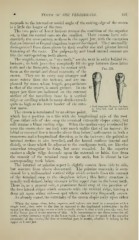Page 431 - My FlipBook
P. 431
* TEETH OF THE VERTEBRATA. 441
responds to the internal or mesial angle of the cutting edge of the crown
is a little the longer of the two.
The two pairs of lower incisors reverse the condition. of the superior
set, in that the central ones are the smallest. Their crowns have sub-
stantially the same pattern as those in the upper jaw, with the exception
that an internal or lingual cingulum is never developed. They are readily
distinguished from those above by their smaller size and greater lateral
flattening of the roots. The pulp-cavity and basal enamel contour are
like the corresponding teeth above.
The cuspids, canines, or " eye teeth," are the next in order behind the
incisors ; in both jaws they completely fill the gap between these latter
teeth and the bicuspids, being in contact with
yig. 219.
them at the mesial and distal extremity of the
crown. They are in every way stronger and
more robust than the incisors, and are im-
planted by roots W'hose length, proportionate
to that of the crown, is much greater. In the
upper jaw these are indicated on the external
surface of the maxillary bone by a vertical
ridge or swelling which in many skulls extends
quite as high as the lower border of the ante-
^. ^ A Left Superior Human Canine:
^
nor nareS. «, external, and h, internal
^'^"''
The crown is terminated by an obtuse point,
which has a position in a line with the longitudinal axis of the root.
Upon either side of this cusp the terminal extremity slopes away, but
still retains a blunt cutting edge. When the median cusp is reduced by
wear the crown does not look very much unlike that of an incisor ; its
labial or external face is broader above than below, ^ and convex in both a
transverse and a longitudinal direction, as in the incisors ; the palatal or
internal surface is also bevelled, and the lateral surfaces (mesial and
distal), or those which lie adjacent to the contiguous teeth, are likewise
somewhat triangular in form, but more rounded. In the superior
canines a slight ridge descends upon the external or labial face from
the summit of the terminal cusp to the neck, but is absent in the
corresponding teeth below.
The internal or palatine aspect is slightly convex from side to side,
but concave from above downward. The palatine convexity is occa-
sioned by a well-marked vertical ridge which extends from the summit
this latter structure
of the terminal cusp to the cingulum below ; is
usually well defined, being stronger in'the upper than in the lower teeth.
There is, as a general rule, a prominent basal cusp at the junction of
the two lateral ridges which connects with the vertical ridge, leaving a
deep pit upon either side—a spot where caries very frequently occurs.
As already stated, the extremity of the crown slopes away upon either
^ When the terms above, below, superior, and inferior are used in connection with a
single tooth, they refer to the free as opposed to the implanted extremities : in the
upper jaw the part of the crown which is really above is that which joins the root, but
in tlie lower jaw it is the reverse of this. It is convenient to use these terms for all
teeth, as they correctly apjily to tlie lower teeth, so that when we s[)eak of the superior
extremity of the crown, the free or terminal part is meant, whether it belong to the
upper or lower jaw.


